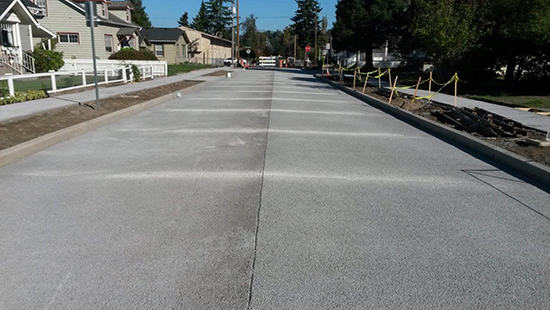|
Subscribe / Renew |
|
|
Contact Us |
|
| ► Subscribe to our Free Weekly Newsletter | |
| home | Welcome, sign in or click here to subscribe. | login |
Construction
| |
 |
April 28, 2016
Pervious concrete

North Neighborhood Streets Improvements
Location: Puyallup
Owner/developer: City of Puyallup
Team: Miles Resources, general contractor; Wilson Concrete Construction, concrete contractor; KPG, structural engineer; Miles Sand & Gravel, ready-mix supplier
The city of Puyallup replaced the deteriorating pavement on a pair of residential blocks with pervious concrete.
Other project elements included new traffic curbs, planter strips, luminaires, street trees, and pervious concrete sidewalks, curb rams and driveway approaches. Water and sewer utilities were also upgraded.
Work was completed last fall.
The project was also notable for what it did not include: replacements or upgrades of storm drainage facilities. The work wasn’t necessary because the project’s components and materials will retain stormwater runoff on site rather than allow it to enter the storm system.
The project helped advance the practice of pervious concrete installation for roads. “Standard” pervious concrete installations require that the concrete be placed quickly after mixing, quickly screed, compacted and finished, and then covered with plastic for a full seven days.
The pervious mix used for the project was altered with an internal curing admixture called HydroMax, which extends the hydration time of the mix by three to seven days. It absorbs a portion of the water in the mix and releases it slowly.
With HydroMax there is no need to cover the concrete with plastic as conventional pervious would require. Normal curing compounds can be used on the surface of the placed concrete after finishing and left open to cure.
One other important benefit of this project was demonstrating the cost effectiveness of pervious concrete over porous asphalt for roadway applications. It is generally accepted that the life-cycle costs of concrete pavement are lower than hot mix asphalt, largely because of the continual maintenance efforts required to keep water out of the subgrade.
Pervious concrete has the same relative life expectancy as Portland cement pavements, with essentially the same life-cycle maintenance costs. What was surprising on this project was that it was bid competitively, porous asphalt vs. pervious concrete. And pervious concrete won on an initial cost basis by $10,000.
In total, this project resulted in the transformation of 28,900 square feet of impervious surfaces to pervious. The change is projected to keep 687,600 gallons of stormwater from entering the storm system annually.
Other Stories:
- GRAND AWARD
Cast-in-place structures
Special applications: Technical merit - Concrete paving
- Artistic and decorative concrete
- Architectural concrete
- Residential decorative concrete
- Public works: Transportation
- Public works: Infrastructure
- Public works: Bridges
- Cast-in-place structures: High-rise
- Tilt-up structures
- Sustainable merit


